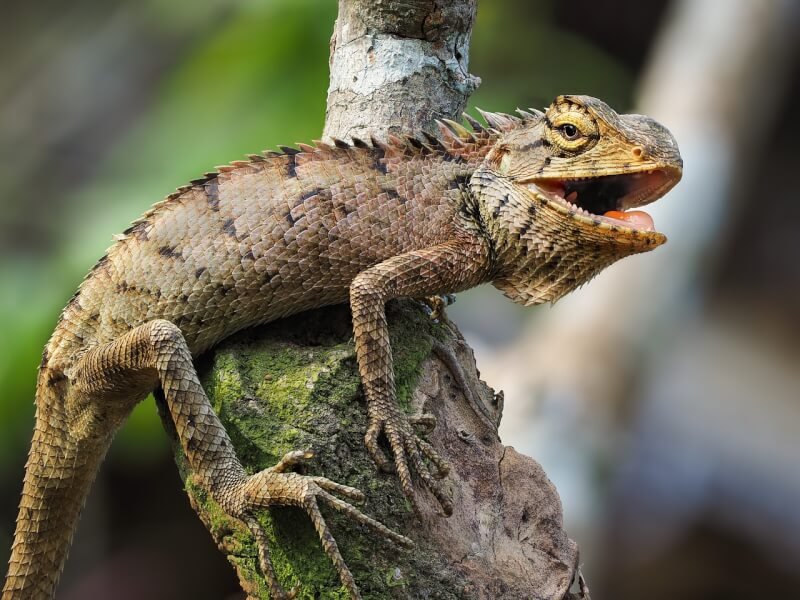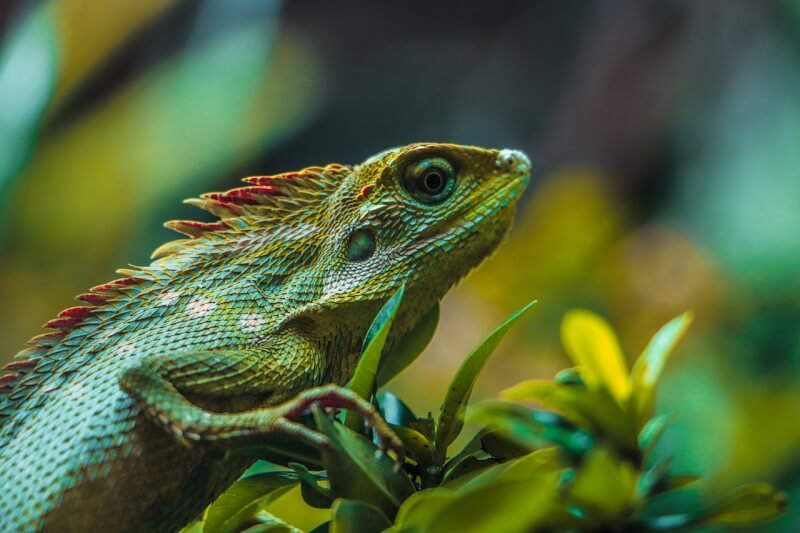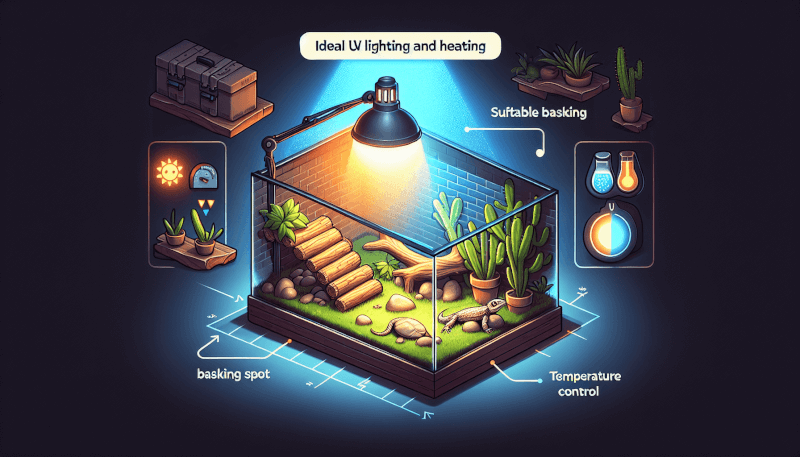Are you a proud reptile owner looking to create the perfect environment for your scaly companion? Look no further! In this article, we will guide you through the process of setting up the ideal UV lighting and heating system for your reptile. By providing the right combination of UV rays and heat, you can ensure your reptile’s overall health and well-being. Let’s explore the key factors to consider and the steps to take in order to create a comfortable and thriving habitat for your reptilian friend.

Choosing the Right UV Lighting
Understanding the Importance of UV Lighting
When it comes to keeping reptiles as pets, providing them with proper UV lighting is crucial for their overall health and well-being. UV lighting is essential because it helps reptiles efficiently metabolize calcium, which is necessary for strong bones and proper growth. Additionally, exposure to UVB rays helps stimulate the production of vitamin D3, which aids in the absorption of dietary calcium. Without adequate UV lighting, reptiles can suffer from a multitude of health problems, including metabolic bone disease and weakened immune systems.
Types of UV Bulbs for Reptiles
There are two main types of UV bulbs commonly used for reptiles: UVB and UVA bulbs. UVB bulbs emit the specific wavelength of UV radiation that reptiles need to synthesize vitamin D3. On the other hand, UVA bulbs produce the visible light spectrum that promotes natural behaviors and enhances the aesthetic appeal of the enclosure. When choosing UV bulbs for your reptile, it’s important to select a bulb that provides a sufficient amount of UVB radiation, typically between 5-12%, depending on the species.
Factors to Consider When Choosing UV Bulbs
When deciding on the right UV bulbs for your reptile’s habitat, there are several factors you should consider. Firstly, you need to determine the appropriate UVB output for your specific reptile species. Different species have varying requirements, so it’s crucial to research and consult with experts to ensure you’re providing the correct amount of UVB radiation. Additionally, consider the size of your reptile’s enclosure, as larger enclosures may require more powerful UV bulbs. Lastly, take into account the lifespan of UV bulbs, as you’ll need to replace them regularly to ensure your reptile receives adequate UV exposure.
Determining the Ideal UV Lighting Placement
Providing a Gradient Environment
Creating a gradient environment within your reptile’s enclosure is vital for their overall well-being. A gradient environment includes areas of varying temperatures and UV exposure, allowing the reptile to choose its preferred temperature and UV levels. This is achieved by placing the UV lighting fixtures asymmetrically within the enclosure, creating a warm basking spot on one end and a cooler area on the other. This way, your reptile can regulate its body temperature and UV exposure by moving around the enclosure as needed.
Considering the Size of the Enclosure
The size of your reptile’s enclosure plays a crucial role in determining the placement of UV lighting. For smaller enclosures, it’s important to position the UV lighting fixtures closer to the basking area, ensuring that your reptile receives adequate UV exposure even when it’s within a limited space. Conversely, larger enclosures require multiple UV fixtures to provide sufficient coverage throughout the entire space. Taking the size of the enclosure into account will help you determine the number and placement of UV lighting fixtures needed to create an optimal environment for your reptile.
Avoiding Direct Exposure to Reptiles
While UV lighting is essential for reptiles, it’s important to ensure that the fixtures are positioned in a way that prevents direct exposure to the animals. Direct exposure to UV radiation for extended periods can be harmful to reptiles and may cause eye damage or burns. To avoid this, securely mount the UV fixtures above a mesh or other barrier that filters and diffuses the UV radiation. This way, your reptile can bask under the UV lighting without being directly exposed to the potentially harmful rays.
Installing UV Lighting Fixtures
Choosing the Right Fixture Type
When it comes to installing UV lighting fixtures in your reptile’s habitat, it’s essential to choose the right type that suits your specific needs. There are various types of fixtures available, including compact fluorescent lights (CFLs) and linear fluorescent lights (T5 or T8). CFLs are suitable for smaller enclosures, while linear fluorescent lights are more appropriate for larger habitats. It’s important to select fixtures that are compatible with the UV bulbs you have chosen to ensure proper functioning and maximum UV output.
Securing the Fixture in the Enclosure
Properly securing the UV lighting fixture is crucial to avoid accidents and ensure the well-being of your reptile. Depending on the type of fixture you choose, there are various installation methods available. For CFL fixtures, you can use clamps or brackets to attach them securely to the top of the enclosure. Linear fluorescent lights typically come with a fixture or housing that can be mounted on the inside of the enclosure. Proper installation will minimize the risk of the fixture falling or causing harm to your reptile.
Positioning the Fixture Correctly
Positioning the UV lighting fixture correctly within the enclosure is essential to provide your reptile with optimal UV exposure. Ideally, the fixture should be mounted at a height that allows the reptile to bask under the light comfortably. Research the specific UV requirements of your reptile species and adjust the distance of the fixture accordingly. Most reptiles require the UV light to be situated approximately 12 to 18 inches away from their basking spot, but this may vary depending on the species and the UV bulb being used. Monitoring your reptile’s behavior and overall health will help you determine if any adjustments need to be made.
Setting Up a Proper Heating System
Understanding the Importance of Heat
Alongside UV lighting, providing a proper heating system is essential for reptiles to thrive in captivity. Reptiles are ectothermic, meaning they rely on external heat sources to regulate their body temperature. Maintaining the right temperature range in their habitat is crucial for their metabolic processes, digestion, and overall health. A suitable heating system helps create a thermal gradient within the enclosure, allowing your reptile to move between warmer and cooler areas as needed to achieve their desired body temperature.
Types of Heating Equipment for Reptiles
There are various types of heating equipment available for reptiles, each serving different purposes. Heat lamps, such as ceramic heat emitters, are commonly used to provide a localized heat source, simulating the warmth of the sun. Under-tank heating pads or heat tape are another option that can be placed underneath the enclosure to create a gentle background heat. Lastly, radiant heat panels are often used to heat larger enclosures and distribute heat evenly throughout the habitat. Consider the specific needs of your reptile species and the size of the enclosure when selecting the appropriate heating equipment.
Determining the Right Temperature Range
To ensure the well-being of your reptile, it’s crucial to maintain the correct temperature range within their habitat. Different reptile species have varying temperature requirements, so it’s important to research and understand the specific needs of your pet. Generally, reptiles require a basking area with a temperature of 90-95°F (32-35°C) and a cooler area that ranges from 75-85°F (24-29°C). It’s important to provide a thermal gradient, allowing your reptile to move between these different temperature zones. Regularly monitor the temperatures using thermometers to ensure they remain within the appropriate range.

Placing Heat Sources Appropriately
Creating a Thermal Gradient
When it comes to placing heat sources within your reptile’s enclosure, creating a thermal gradient is key. This involves positioning the heat sources in a way that provides different temperature zones, allowing your reptile to regulate its body temperature as needed. Place the primary heat source, such as a heat lamp or radiant heat panel, on one side of the enclosure to create a warmer basking area. On the opposite side, provide a cooler area without direct heat to allow your reptile to escape the heat and maintain a comfortable body temperature.
Avoiding Hotspots
While providing sufficient heat is important, it’s crucial to avoid creating hotspots within the enclosure. Hotspots occur when heat sources are concentrated in a single area, leading to excessively high temperatures that can be harmful to your reptile. This can cause burns, dehydration, and stress. To prevent hotspots, ensure that heat sources are well-distributed throughout the enclosure and monitor the temperatures using thermometers regularly. Adjust the placement and power of the heat sources as needed to maintain a consistent and comfortable temperature gradient.
Providing Multiple Heat Sources
In larger enclosures, it may be necessary to provide multiple heat sources to ensure proper temperature regulation throughout the habitat. By strategically placing multiple heat sources, you can create different temperature zones that cater to the various needs of your reptile. A combination of basking lamps, under-tank heating pads, and radiant heat panels can help distribute heat evenly and provide your reptile with options to find its preferred temperature. Monitor the temperatures in different areas of the enclosure to ensure that the various heat sources are effectively maintaining the desired thermal gradient.
Monitoring Temperature and UV Levels
Using Thermometers and Hygrometers
To maintain a healthy and comfortable environment for your reptile, it’s important to regularly monitor the temperature and humidity levels. Using thermometers and hygrometers specifically designed for reptile habitats will help you accurately assess the conditions within the enclosure. Place thermometers both at the basking spot and in the cooler areas to ensure the desired temperature gradient is maintained. Hygrometers will help you monitor and adjust the humidity levels, ensuring they stay within the appropriate range for your reptile species.
Regularly Checking the Temperatures
Regularly checking the temperatures within your reptile’s enclosure is essential to ensure they remain within the appropriate range. Fluctuations in temperature can negatively impact your reptile’s health and well-being. Check the temperatures at different times of the day, as they may vary due to external factors such as room temperature or changes in weather. Make adjustments to the heat sources accordingly to maintain stability and consistency in the thermal gradient.
Using UV Meters to Measure UV Output
UV meters are valuable tools for measuring the UV output of your UV bulbs. They help determine the effectiveness and intensity of the UV radiation being emitted, ensuring your reptile is receiving adequate UV exposure. By regularly measuring the UV output, you can assess whether the UV bulbs need to be replaced or repositioned within the enclosure. Monitoring and maintaining proper UV levels will contribute to the overall health and well-being of your reptile.

Creating a Natural Environment
Replicating the Reptile’s Natural Habitat
Creating a natural environment within your reptile’s habitat is essential to promote their natural behaviors and provide them with a sense of security. Research the specific species of your reptile and try to replicate their natural habitat as closely as possible. Consider factors such as the type of substrate, vegetation, hiding places, and climbing structures that would be found in their natural environment. By recreating these elements, you create a more enriching and stimulating environment for your reptile.
Adding Hiding Places and Basking Spots
Hiding places and basking spots are essential components of a reptile’s habitat. Providing adequate hiding places, such as caves or branches, allows your reptile to retreat and feel secure when they need privacy or want to escape from the light and heat. Basking spots, on the other hand, are areas where your reptile can comfortably soak up the warmth of the UV and heat sources. These spots should be easily accessible and positioned within the appropriate temperature and UV gradient zones within the enclosure.
Incorporating Live Plants or Decorations
Live plants and decorations not only enhance the aesthetic appeal of your reptile’s enclosure but also contribute to its overall well-being. Live plants provide a more natural and enriching environment, offering hiding spots, climbing opportunities, and additional oxygenation. Additionally, certain live plants can help regulate humidity levels and provide added benefits, such as an edible food source or creating a more realistic habitat for your reptile. When selecting live plants, ensure they are safe for your reptile and compatible with the lighting and heating systems in place.
Maintaining and Replacing UV Bulbs
Understanding the Lifespan of UV Bulbs
UV bulbs have a limited lifespan and gradually lose their effectiveness over time. It’s important to understand the lifespan of your UV bulbs and know when they need to be replaced to ensure your reptile continues to receive adequate UV exposure. UVB bulbs typically have a lifespan of around 6-12 months, while UVA bulbs can last up to 12-18 months. However, it’s crucial to regularly monitor the UV output using UV meters and pay attention to any signs of reduced performance to determine if the bulbs need to be replaced sooner.
Regularly Inspecting and Cleaning Bulbs
Regularly inspecting UV bulbs is important to ensure they are functioning correctly and providing the necessary UV radiation. Check for any signs of damage, such as cracks or discoloration, as these can compromise the output and effectiveness of the bulbs. Additionally, cleaning the bulbs on a regular basis helps remove any dust or debris that may accumulate and obstruct the UV radiation. Use a soft cloth or specialized bulb cleaning products to gently wipe the bulbs, ensuring they remain clean and free from obstructions.
Knowing When to Replace UV Bulbs
Knowing when to replace UV bulbs is essential for maintaining the health and well-being of your reptile. Keep a record of when you initially installed the bulbs and monitor the UV output with a UV meter regularly. If the UV output drops below the recommended levels for your reptile species, it’s time to replace the bulbs. Additionally, if the bulbs have reached their expected lifespan or exhibit signs of damage or reduced performance, it’s best to replace them to ensure your reptile receives optimal UV exposure.

Overcoming Common Challenges
Dealing with Overheating Enclosures
Overheating enclosures can pose a serious risk to the health of your reptile. If the temperatures within the enclosure consistently exceed the desired range, steps must be taken to address the issue. Start by checking the functioning of the heat sources and adjust their positioning or wattage accordingly. Additionally, ensure proper ventilation within the enclosure to allow heat to dissipate effectively. If the issue persists, consult with a veterinarian or reptile expert who can provide guidance on specific steps to address overheating in your reptile’s habitat.
Addressing Insufficient UV Exposure
Insufficient UV exposure can have detrimental effects on the health of your reptile. If you notice signs of vitamin D3 deficiency, such as soft or deformed shells in turtles or lethargy in lizards, it may indicate a lack of UV exposure. Confirm that the UV bulbs are functioning correctly and positioned at the appropriate height and distance. If the UV output is still insufficient, consider upgrading to a higher-output UV bulb or increasing the number of UV fixtures in the enclosure. It’s crucial to monitor your reptile’s behavior and overall health to ensure they receive the necessary UV exposure.
Preventing Burn Injuries
Burn injuries can occur when reptiles come into direct contact with heat sources or UV bulbs that are too close or emit excessive heat. To prevent burn injuries, place heat lamps and UV fixtures at a safe distance from your reptile’s basking spots. Use protective covers or mesh guards to prevent direct contact with the hot lamps or bulbs. Additionally, regularly monitor the temperatures within the enclosure using thermometers and adjust the positioning or power of the heat sources to prevent overheating.
Seeking Professional Advice
Consulting with a Veterinarian or Herpetologist
When it comes to providing the best possible care for your reptile, seeking professional advice is invaluable. Veterinarians specializing in reptiles or herpetologists can offer expert guidance specific to your reptile species and help you navigate any challenges or concerns you may have. They can provide customized advice on UV lighting, heating systems, enclosure setup, and overall reptile care, ensuring that you create and maintain the ideal environment for your unique pet.
Getting Customized Advice for Your Reptile
Every reptile species has unique requirements and preferences when it comes to their UV lighting and heating setups. To ensure you are meeting these specific needs, it’s important to seek customized advice tailored to your reptile. Online forums, reptile enthusiast groups, and reptile expos are great places to connect with experienced reptile keepers who can provide insights and share their experiences. By sharing information about your reptile’s species, size, and particular needs, you can receive personalized advice that will help you create the ideal UV lighting and heating setup.
Keeping Up with Latest Research
The field of reptile care is constantly evolving, with new research and advancements being made regularly. Stay up to date with the latest research and developments in reptile husbandry to ensure you are providing the best care for your reptile. Research published in scientific journals, reputable online sources, and following respected experts in the field will help you stay informed and make informed decisions about your reptile’s lighting, heating, and overall care. By staying current, you can continuously improve and refine the setup of your reptile’s habitat to meet their changing needs.

